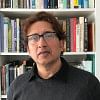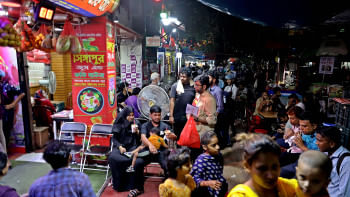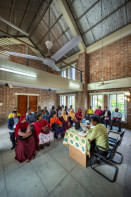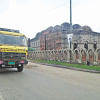A post-Partition heritage campus worth preserving

I have been thinking a lot about the politically tempestuous period from 1947 to 1971 from the vantage of architectural history. We all know that it was a period of extraordinary political vitality that eventually produced Bangladesh. What we don't know enough is that this period also produced an extraordinary body of architectural work in the then East Pakistan. This raises two provocative interrelated questions: first, does good politics (Bangalee agitation for self-rule) produce good architecture; and second, does architecture mirror the sociocultural spirit of a nation at a particular time in its evolution?
The following examples provide ample opportunities to deliberate on these questions: Muzharul Islam's Institute of Fine Arts (1956), University of Dhaka Library (1955), and the National Institute of Public Administration building (1964); Louis Kahn's Parliament Complex (began in 1964); Constantinos Doxiadis's Teacher-Student Centre (1961) and Bangladesh Academy for Rural Development (1959-1960), Daniel Dunham and Robert Boughey's Kamalapur Railway Station (1968), Richard Vrooman's Architecture building (1964), Paul Rudolph's Bangladesh Agricultural University in Mymensingh (1961-62), Dhaka New Market (1954), and Biponi Bitan (1964) in Chattogram, among other examples.
There is another extraordinary icon from this period that most people don't know about: Faujdarhat Cadet College (FCC), a world-class, semi-military residential academic institution (from Classes 7 to 12, thus called a college), located north of Chattogram, and a unique example of environmentally conscious campus planning, the first of its kind, in my view, in post-Partition South Asia.
Faujdarhat Cadet College was built during the heyday of the Language Movement, heralding a remarkable period of building design innovation in East Pakistan. In many ways, the planning and design of FCC, under the leadership of Colonel William Maurice Brown of the New Zealand Army, inaugurated a "golden age" of exemplary building activity in East Pakistan. FCC's design, along with Muzharul Islam's Institute of Fine Arts, signalled the advent of modern architecture and planning to the then East Pakistan.
Sadly, it has recently come to light that some of the most significant buildings of FCC will be torn down to "modernise" and "expand" the educational complex. Deserving of a UNESCO heritage status, FCC should be modernised without the alteration and demolition of a single building. Engineering solutions to strengthen and extend the life of a building and retrofit it with modern amenities are commonplace today. Mature nations need physical memories. Heritage buildings—like literature, art, painting, and music—are collective memories that nations build their identities on.
FCC should not be viewed simply as one of the cadet colleges of Bangladesh. It is a heritage campus that can be showcased to the world. Its unique affiliation with this country's political and architectural legacy cannot be overemphasised. Many Faujians—as the alumni of this college are called—participated in the 1971 Liberation War, some of whom embraced martyrdom. We must champion FCC as part of our national history and preserve what makes this college a unique case of sustainable campus planning in South Asia. If Eton College, a prestigious school near Windsor in Berkshire, England, founded in 1440 by King Henry VI, could be preserved for nearly 600 years, we can preserve FCC while retrofitting it with modern technologies as well.
FCC's environment-conscious campus planning was far advanced for its time, even in the world, during the 1950s. In the middle of the 20th century, the prevailing architectural philosophy was to make buildings the focal point on a site or landscape at the expense of their integration with environmental conditions and their ecosystem. The environmental movement in the West that would challenge the corporate and capitalistic control of nature, as well as a formalist approach to building design, began in the 1960s. Rachel Carson's trendsetting environmental manifesto, Silent Spring, was published in 1962, helping create some of the pivotal environmental laws in 1970.

FCC was already an exception in the 1950s. It was planned to blend with a specific hydro-geographical location and its unique hill-valley-sea ecology near the Bay of Bengal. Its symmetric campus plan is anchored by the academic building as its crown jewel and the dining room axially behind it. The academic building-dining room complex is flanked by the staggered placement of four residential houses and other facilities. The overall symmetry of the master plan symbolises discipline, in sync with military ethos, moral integrity, and visual order. The separation of private (residential) and public zones (academic building, parade ground, and sports facilities) is most functionally and seamlessly achieved. All buildings on campus, including the academic building, dining hall, workshops, residential buildings, and mosque, are connected by open corridors, a planning philosophy most suitable for a tropical climate with abundant rain.
Not only was there no hill cut during the construction of FCC, but all buildings were set on different topographic terraces—from the hills in the east to the Bay of Bengal in the west—achieving an extraordinary drainage system for runoff from the hills. No Faujian has ever seen waterlogging at his alma mater! The drainage masterplan of the campus was done in harmony with the site's natural gradient. Drains follow topographic lines, becoming nature's spontaneous ally and carrying water to lowlands. Local governments and city administrators in Bangladesh can learn much from FCC's drainage master plan.
All buildings at FCC face the Dhaka-Chattogram Highway and the Bay of Bengal, not only in a symbolic gesture but also in the best orientation to catch the prevailing wind and keep all buildings naturally ventilated. The FCC buildings are modernistic in their aesthetic expression, yet they employ time-tested natural airflow techniques that enrich traditional buildings. The residential buildings face west but avoid the direct heat of the fierce tropical sun by incorporating deep corridors on the west as an additional building layer that keeps the living quarters cool.
FCC's unique affiliation with this country's political and architectural legacy cannot be overemphasised. Many Faujians—as the alumni of this college are called—participated in the 1971 Liberation War, some of whom embraced martyrdom. We must champion FCC as part of our national history and preserve what makes this college a unique case of sustainable campus planning in South Asia. If Eton College, a prestigious school near Windsor in Berkshire, England, founded in 1440 by King Henry VI, could be preserved for nearly 600 years, we can preserve FCC while retrofitting it with modern technologies as well.
The Mughals and the British utilised these building techniques when they arrived in this part of the world. It won't be an exaggeration to say that the United Nations' Sustainable Development Goals (SDGs) were achieved in FCC's campus planning, more than 50 years before the UN body presented such goals to the world communities.
Given the historical and environmental significance of FCC, any alteration and re-planning of this heritage campus should be considered only under the sustained guidance of an advisory body—an oversight committee—consisting of alumni experts and building professionals who understand the spirit of the place and the technique of retrofitting that can extend the life cycle of heritage buildings. That way, we can ensure that any efforts to upgrade the FCC campus are consistent with the college's original aesthetic, environmental, and educational intents.

The heritage status of FCC, however, should not be seen as a hindrance to adaptation and modernisation. The institution itself should remind us that there is always a great opportunity to reform cadet college education to meet the dynamic demands of the 21st century. How prepared are the current cadets to face the challenges of today's knowledge-based world? FCC was founded over 60 years ago. Have we revisited its pedagogy and curriculum to debate what worked and what didn't? Do cadet colleges employ teachers to prepare and train cadets to be the leaders of a new Bangladesh, with its geostrategic standing in the world rising? It is essential that we consider, alongside any re-planning and upgrading initiatives, the curricular restructuring of cadet college education.
We should consider including in any future expansion plan for FCC a Centre for Teaching Excellence to produce the next generation of quality teachers for all cadet colleges. It would not be in our national interest to expand the enrolment capacity of cadet colleges, while the quality of cadet college teachers remains unsatisfactory. Without producing world-class teachers, increasing the student enrolment in cadet colleges will remain unsustainable and even counterproductive.
Other future initiatives may include a Global Educators Collaborative, a platform to recruit FCC alumni who serve as faculty members at top academic institutions around the world. Even if they teach at FCC for a short period of time as guest faculty or spend their sabbatical term there, it would be an invaluable resource for current students. This initiative will foster a multidisciplinary knowledge culture, inspiring current cadets to think globally and critically. Furthermore, this collaboration is likely to spur a curricular reform in concert with world-class academic standards.
A pioneer of campus planning in South Asia, Faujdarhat Cadet College is a milestone in the history of our nation. Its preservation in its original intent would mean respecting the history of our national evolution. The ageing buildings of the campus can easily be structurally strengthened and retrofitted with modern amenities. The key point is being mature about protecting history, one that powered our nation-building.
Dr Adnan Zillur Morshed is professor of architecture at the Catholic University of America in Washington, DC, and executive director of the Centre for Inclusive Architecture and Urbanism at BRAC University. He is an alumnus of Faujdarhat Cadet College (Batch 24).
Views expressed in this article are the author's own.
Follow The Daily Star Opinion on Facebook for the latest opinions, commentaries and analyses by experts and professionals. To contribute your article or letter to The Daily Star Opinion, see our guideline for submission.

 For all latest news, follow The Daily Star's Google News channel.
For all latest news, follow The Daily Star's Google News channel. 









Comments